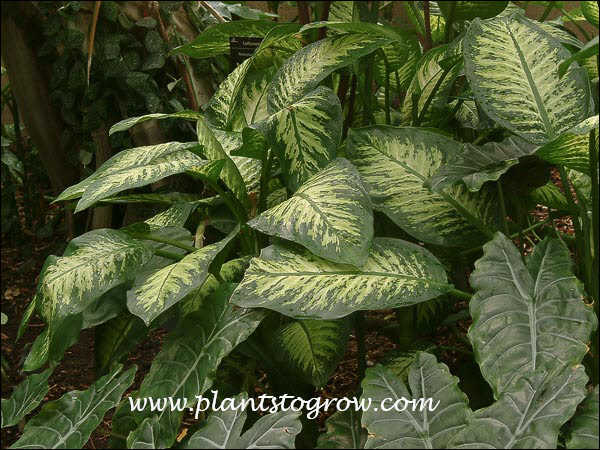| Description | A large growing member of the Dumb Cane with white variegated leaves. All parts of the plants are poisonous. |
|---|---|
| Pronunciation | (deef-en-BACH-ee-uh) |
| Plant Type | All Plants, Indoor Foliage |
| Sunlight | bright to moderate, tolerates low, never direct, at least 400 foot candles |
| Moisture | average, evenly moist, slightly dry |
| Growing Media | average |
| Temperature | prefers warm 70-80 degrees, tolerates average house, death at 50 degrees |
| Flowers | spathes, not ornamental |
| Leaves | green leaves and veins, cream to white varigation in the center |
| Stems | thick cane-like |
| Dimensions | 4 plus feet |
| Maintenance | With time the plant will lose the bottom leaves and the plant should be cut back. The plant will easily resprout leaves on the stem from the existing buds. Be aware that the sap is toxic and can burn the skin, so gloves are recommended when cutting back large stems. |
| Propagation | It can be rooted from tip cuttings, air-layered or cane cuttings (Stem section). A friend of mine (who was one of the people that this plant grew like a weed for) gave me 3, four foot stems from a large plant he cut back. I proceeded to cut the stems into to 6" sections to root. This was the first time I cut back Dieffenbachia and it was the first and last time I handled cuttings without gloves. The sap caused major irritation to my skin. The sections can be either laid flat, or stuck into the rooting media. They will form roots and new stems. |
| Native Site | Central and South America |
| Cultivar Origin | Dieffenbachia was named by Heinrich Wilhelm Schott, the Director of the Botanical Gardens in Vienna, to honor his head gardener Joseph Dieffenbach (1796–1863). |
| Misc Facts | These plants contain needle-like crystals of calcium oxalate that penetrate and irritate tissues of the mouth and throat. Chemicals in the sap can also cause inflammation of mucous membranes. Plants in this family include dieffenbachia, philodendron, caladium, and elephant's ear. Symptoms of poisoning from dieffenbachia are intense burning and irritation of the mouth, tongue, and lips. Although rare, if the reaction is severe enough, the swelling can seal off the breathing passages. Philodendron, caladium, and elephant's ear produce the same types of symptoms when ingested. If a piece of the corm (underground stem) is eaten, symptoms are a burning of the mouth and throat. Jack-in-the-pulpit is a native member to watch in this family. (www.plantkingdom.com) |
| Notes & Reference | #158-Plantepedia (Maggie Stuckey) |

Cart


